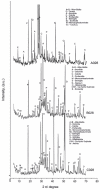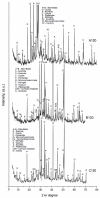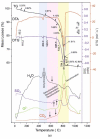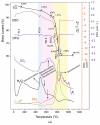Crystal-Chemical and Thermal Properties of Decorative Cement Composites
- PMID: 34500884
- PMCID: PMC8432547
- DOI: 10.3390/ma14174793
Crystal-Chemical and Thermal Properties of Decorative Cement Composites
Abstract
The advanced tendencies in building materials development are related to the design of cement composites with a reduced amount of Portland cement, contributing to reduced CO2 emissions, sustainable development of used non-renewal raw materials, and decreased energy consumption. This work deals with water cured for 28 and 120 days cement composites: Sample A-reference (white Portland cement + sand + water); Sample B-white Portland cement + marble powder + water; and Sample C white Portland cement + marble powder + polycarboxylate-based water reducer + water. By powder X-ray diffraction and FTIR spectroscopy, the redistribution of CO32-, SO42-, SiO44-, AlO45-, and OH- (as O-H bond in structural OH- anions and O-H bond belonging to crystal bonded water molecules) from raw minerals to newly formed minerals have been studied, and the scheme of samples hydration has been defined. By thermal analysis, the ranges of the sample's decomposition mechanisms were distinct: dehydration, dehydroxylation, decarbonation, and desulphuration. Using mass spectroscopic analysis of evolving gases during thermal analysis, the reaction mechanism of samples thermal decomposition has been determined. These results have both practical (architecture and construction) and fundamental (study of archaeological artifacts as ancient mortars) applications.
Keywords: cement replacement materials; marble powder; reaction mechanism; thermal properties; white Portland cement.
Conflict of interest statement
The authors declared no conflict of interest.
Figures














References
-
- Andrew R.M. Global CO2 emissions from cement production. Earth Syst. Sci. Data Discuss. 2018;10:195–217. doi: 10.5194/essd-10-195-2018. - DOI
-
- Cloete S., Giuffrida A., Romano M.C., Zaabout A. Economic assessment of the swing adsorption reactor cluster for CO2 capture from cement production. J. Clean. Prod. 2020;275:123024. doi: 10.1016/j.jclepro.2020.123024. - DOI
-
- Korhonena J., Honkasalob A., Seppälä J. Circular Economy: The Concept and its Limitations. Ecol. Econ. 2018;143:37–46. doi: 10.1016/j.ecolecon.2017.06.041. - DOI
-
- Agyabeng-Mensah Y., Tang L., Afum E., Baah C., Dacosta E. Organisational identity and circular economy: Are inter and intra organisational learning, lean management and zero waste practices worth pursuing? Sustain. Prod. Consum. 2021;28:648–662. doi: 10.1016/j.spc.2021.06.018. - DOI
LinkOut - more resources
Full Text Sources

